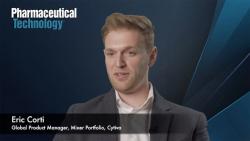
OR WAIT null SECS
- About Us
- Advertise
- Contact Us
- Editorial Info
- Editorial Contacts
- Editorial Advisory Board
- Do Not Sell My Personal Information
- Privacy Policy
- Terms and Conditions
© 2024 MJH Life Sciences™ and Pharmaceutical Technology. All rights reserved.
Taking a Deeper Look at Sterile Powder Transfer in Aseptic Fill/Finish of Parenterals (INTERPHEX 2024)
Mary Van Gaasbeck, technical services specialist, LS Equipment and Services, at STERIS Life Sciences, notes that automation is key when it comes to effective sterile powder transfer of parenteral drug products.
Pharmaceutical Technology® spoke with Mary Van Gaasbeck, technical services specialist, LS Equipment and Services, at STERIS Life Sciences at INTERPHEX 2024 to explore issues surrounding sterile powder transfer during aseptic fill/finish of parenteral drug products.
In the discussion, Van Gaasbeck noted that the selection between a powder form or aqueous form ultimately depends on the intended effects of the final drug products. “With powder forms of parenteral drug products, they do have a longer shelf life, and they do not always require the complex cold storage that some of the liquid or aqueous forms do. One thing to note [with] the aqueous forms [is that] they are faster-acting, [and] they are absorbed quicker into the body than their powder alternatives, but they do require cold storage and cold-storage management. And then, of course, they have a shorter shelf life than the powder forms,” Van Gaasbeck stated.
Van Gaasbeck presented on effective sterile powder transfer of parenteral drugs at INTERPHEX, where she emphasized that dry powder forms pose a challenge for aseptic transfer because the powder itself can generate contaminants through the particulates during the powder transfer process. “One thing to note as well,” she added, “is that particulates can contaminate the ISO 5 or Grade A area where the product is being filled. [They] can also pose a risk to operator safety if the powder product is very potent, like many powder products are. Containment of that and maintaining that aseptic barrier is very challenging and important in those transfer processes.”
Another important point that Van Gaasbeck makes is that “automation is key” for effective sterile powder transfer of parenterals. “Automation and containment go hand-in-hand,” she remarked. Thus, finding technologies and other automated techniques that allow for the elimination of operator manipulations could provide extended containment through closed channels and closed systems. “Using the beauty of automation, you can eliminate that operator interference and eliminate the additional uses of transfer vessels and isolators that are posing that additional environmental contamination risks,” she said.
The future of aseptic fill/finish operations may lie in shows such as INTERPHEX, Van Gaasbeck noted. “INTERPHEX is a great showcase for the next steps and next innovation in aseptic transfer or aseptic powder filling. There are [many] different robotic systems that can [significantly] minimize operator impact, and they can automate these types of transfer processes,” she observed. “This is a great show to find those new and up-to-date automated technologies that are available. I would also think that AI [artificial intelligence] is going to play a crucial role in the future of [sterile] transfer and how those types of processes are conducted, how they're managed, and then—over time—how they are tracked.”
INTERPHEX 2024 was held in New York City on April 16–18, 2024.


